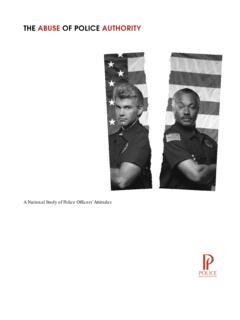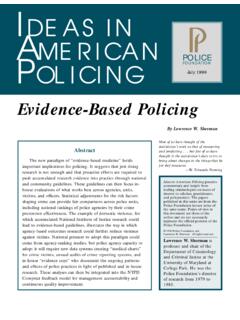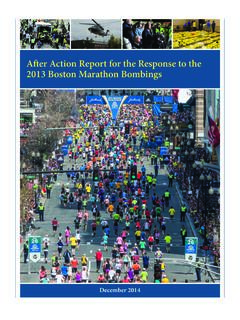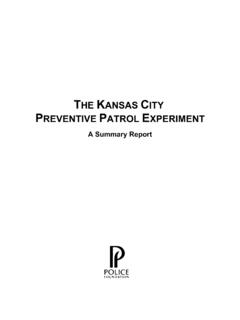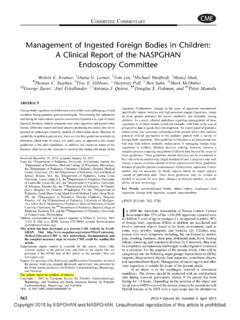Transcription of POLICE FOUNDATION REPORTS
1 POLICE FOUNDATION REPORTS . April 1984. The Minneapolis Domestic Violence Experiment By Lawrence W. Sherman and Richard A. Berk Under a grant from the National Institute of Justice, the Minneapolis POLICE Department and the POLICE FOUNDATION conducted an experiment from early 1981 to mid-1982 testing POLICE responses to domestic violence. A technical report of the experiment can be found in the April 1984 issue of the American Sociological Review. This report summarizes the results and implications of the experiment. It also shows how the experiment was designed and conducted so the reader may understand and judge the findings. Findings in Brief Why the Experime nt Policing Domestic Was Conducted Assaults The Minneapolis domestic violence experiment was the first The purpose of the experiment POLICE have been typically scientifically controlled test of was to address an intense debate reluctant to make arrests for the effects of arrest for any about how POLICE should respond domestic violence (Berk and crime.)
2 It found that arrest was to misdemeanors, cases of Loseke, 1981), as well as for a the most effective of three domestic violence. At least three wide range of other kinds of standard methods POLICE use to viewpoints can be identified in offenses, unless a victim reduce domestic violence. The this debate: demands an arrest, a suspect other POLICE methods 1. The traditional POLICE insults an officer, or other factors attempting to counsel both approach of doing as little as are present (Sherman, 1980). parties or sending assailants possible, on the premise that Parnas' (1972) observations of away from home for several offenders will not be punished by the Chicago POLICE found four hours were found to be the courts even if they are categories of POLICE action in considerably less effective in arrested, and that the problems these situations: negotiating or deterring future violence in the are basically not solvable.
3 Otherwise talking out the cases examined. These were not dispute; threatening the life-threatening cases, but rather 2. The clinical psychologists' disputants and then leaving;. the minor assaults which make recommendations that POLICE asking one of the parties to leave up the bulk of POLICE calls to actively mediate or arbitrate the premises, or, very rarely, domestic violence. disputes underlying the violence, making an arrest. restoring peace but not making The findings, standing alone as any arrests. Similar patterns are found in the result of one experiment, do many other cities. Surveys of not necessarily imply that all 3. The approach recommended battered women who tried to suspected assailants in domestic by many women's groups and the have their domestic assailants violence incidents should be POLICE Executive Research Forum arrested report that arrest arrested.
4 Other experiments in (Loving, 1980) of treating the occurred in only ten percent (Roy, other settings are needed to learn violence as a criminal offense 1977:35) or three percent (see more. But the preponderance of subject to arrest. Langley and Levy, 1977:219) of evidence in the Minneapolis the cases. Surveys of POLICE study strongly suggests that the If the purpose of POLICE responses agencies in Illinois (Illinois Law POLICE should use arrest in most to domestic violence calls is to Enforcement Commission, 1978). domestic violence cases. reduce the likelihood of that and New York (Office of the violence recurring, the question Minority Leader, 1978) found is which of these approaches is explicit policies against arrest in more effective than the others?
5 The majority of the agencies surveyed. Despite the fact that officers found that over 70 How the Experiment violence is reported to be present percent reported a family crisis Was Designed in one-third (Bard and Zacker, intervention training program in 1974) to two-thirds (Black, 1980) operation. Although it is not of all domestic disturbances clear whether these programs In order to find which POLICE POLICE respond to, POLICE reduced separation and increased approach was most effective in department data show arrests in mediation, a decline in arrests deterring future domestic only five percent of those was noted for some (Wylie, et al., violence, the POLICE FOUNDATION disturbances in Oakland (Hart, 1976).)
6 Indeed, many sought and the Minneapolis POLICE , cited in Meyer and Lorimer, explicitly to reduce the number of Department agreed to conduct a 1977:21), six percent of those arrests (University of Rochester, classic experiment. disturbances in a Colorado city 1974; Ketterman and Kravitz, (Patrick, Ellis, and Hoffmeister, 1978). A classic experiment is a , cited in Meyer and Lorimer, research design that allows 1977:21), and six percent in Los By the mid-1970s, POLICE scientists to discover the effects Angeles County (Emerson, 1979). practices were criticized from the of one thing on another by opposite direction by feminist holding constant all other The best available evidence on groups. Just as psychologists possible causes of those effects.
7 The frequency of arrest is the succeeded in having many POLICE The design of the experiment observations from the Black and agencies respond to domestic called for a lottery selection, Reiss study of Boston, violence as half social work and which ensured that there would Washington, and Chicago POLICE half POLICE work, feminists began be no difference among the three in 1966 (Black, 1980:182). POLICE to argue that POLICE put too groups of suspects receiving the responding to disputes in those much emphasis on the social different POLICE responses (Cook cities made arrests in 27 percent work aspect and not enough on and Campbell, 1979). The lottery of violent felonies and 17 percent the criminal (Langley and Levy, determined which of the three of the violent misdemeanors.)
8 1977:218). Widely publicized responses POLICE officers would Among married couples (Black, lawsuits in New York and use on each suspect in a domestic 1980:158), they made arrests in Oakland sought to compel POLICE assault case. According to the 26 percent of the cases, but tried to make arrests in every case of lottery, a suspect would be to remove one of the parties in 38 domestic assault, and state arrested, or sent from the scene percent of the cases. legislatures were lobbied of the assault for eight hours, or successfully to reduce the given some form of advice, which The apparent preference of many evidentiary requirements needed could include mediation at an POLICE for separating the parties for POLICE to make arrests for officer's discretion.
9 In the rather than arresting the misdemeanor domestic assaults. language of the experiment, offender has been attacked from Some legislatures are now these responses were called the two directions over the past 15 considering statutes requiring arrest, send, and advise years. The original critique came POLICE to make arrests in these treatments. The design called for from clinical psychologists who cases. a six-month follow-up period to agreed that POLICE should rarely measure the frequency and make arrests (Potter, 1978:46; The feminist critique was seriousness of any future Fagin, 1978:123-124) in domestic bolstered by a study ( POLICE domestic violence in all cases in assault cases and argued that FOUNDATION , 1976) showing that which the POLICE intervened.
10 POLICE should mediate the for 85 percent of a sample of disputes responsible for the spouse killings, POLICE had The design applied only to simple violence. A highly publicized intervened at least once in the (misdemeanor) domestic demonstration project teaching preceding two years. For 54 assaults, where both the suspect POLICE special counseling skills for percent of those homicides, POLICE and the victim were present family crisis intervention (Bard, had intervened five or more when the POLICE arrived. Thus, 1970) failed to show a reduction times. But it was impossible to the experiment included only in violence, but was interpreted determine from the data whether those cases in which POLICE were as a success nonetheless.
